Discover how a bimodal integration strategy can address the major data management challenges facing your organization today.
Get the Report →Create Dynamic EnterpriseDB Grids Using the Infragistics XamDataGrid
Learn how you can connect EnterpriseDB to Infragistics XamDataGrid to build dynamic grids.
Using Infragistics WPF UI controls, you can build contemporary applications reminiscent of Microsoft Office for both desktop and touch-based devices. When coupled with the CData ADO.NET Provider for EnterpriseDB, you gain the capability to construct interactive grids, charts, and various other visual elements while directly accessing real-time data from EnterpriseDB data. This article will guide you through the process of creating a dynamic grid within Visual Studio using the Infragistics XamDataGrid control.
You will need to install the Infragistics WPF UI components to continue. Download a free trial here: https://www.infragistics.com/products/wpf.
Create a WPF Project
Open VisualStudio and create a new WPF project.
Add a TextBox for passing a SQL query to the CData ADO.NET Provider and a Button for executing the query.
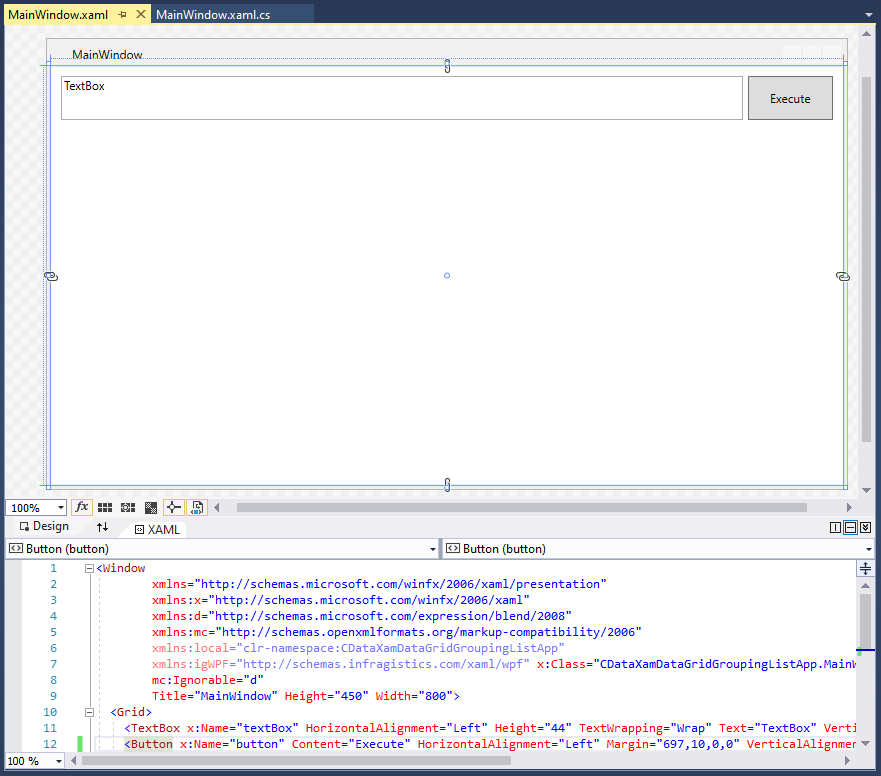
The XAML at this stage is as follows:
< Window
xmlns="http://schemas.microsoft.com/winfx/2006/xaml/presentation"
xmlns:x="http://schemas.microsoft.com/winfx/2006/xaml"
xmlns:d="http://schemas.microsoft.com/expression/blend/2008"
xmlns:mc="http://schemas.openxmlformats.org/markup-compatibility/2006"
xmlns:local="clr-namespace:CDataXamDataGridGroupingListApp"
xmlns:igWPF="http://schemas.infragistics.com/xaml/wpf" x:Class="CDataXamDataGridGroupingListApp.MainWindow"
mc:Ignorable="d"
Title="MainWindow" Height="450" Width="800">
< Grid>
< TextBox x:Name="textBox" HorizontalAlignment="Left" Height="44" TextWrapping="Wrap" Text="TextBox" VerticalAlignment="Top" Width="682" Margin="10,10,0,0"/>
< Button x:Name="button" Content="Execute" HorizontalAlignment="Left" Margin="697,10,0,0" VerticalAlignment="Top" Width="85" Height="44"/>
< /Grid>
< /Window>
Add and Configure a XamDataGrid
After adding the initial controls, add a XamDataGrid to the App. The component will appear in the Visual Studio toolbox.
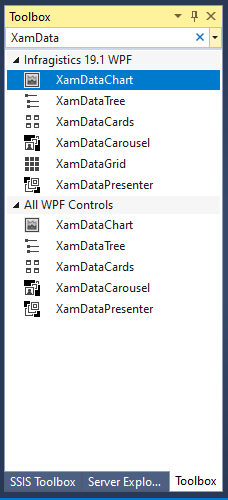
Arrange the component on the designer so that it is below the TextBox & Button and linked to the boundaries of the app.
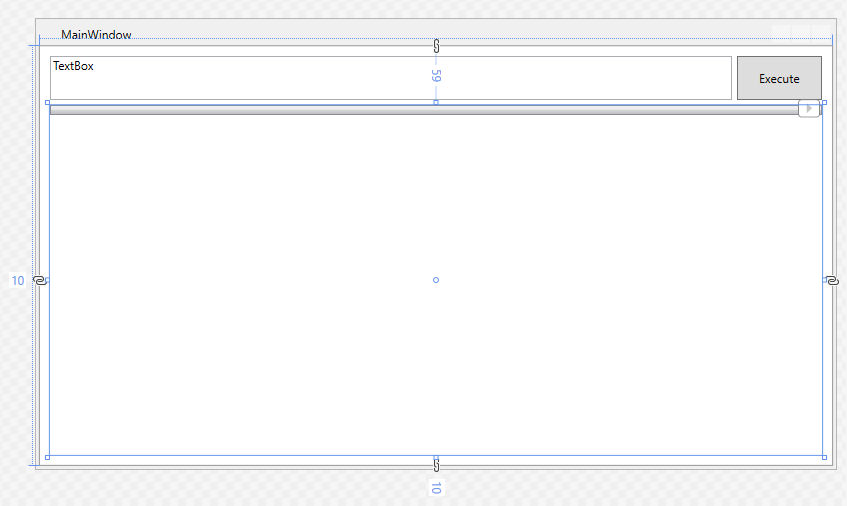
Once the XamDataGrid is placed, edit the XAML to set the XamDataGrid DataSource attribute to "{Binding}" and set the FieldSettings AllowRecordFiltering and AllowSummaries attributes to "true." Next, add an empty method as the Click event handler for the Button component. The XAML at this stage is as follows:
< Window
xmlns="http://schemas.microsoft.com/winfx/2006/xaml/presentation"
xmlns:x="http://schemas.microsoft.com/winfx/2006/xaml"
xmlns:d="http://schemas.microsoft.com/expression/blend/2008"
xmlns:mc="http://schemas.openxmlformats.org/markup-compatibility/2006"
xmlns:local="clr-namespace:CDataXamDataGridGroupingListApp"
xmlns:igWPF="http://schemas.infragistics.com/xaml/wpf" x:Class="CDataXamDataGridGroupingListApp.MainWindow"
mc:Ignorable="d"
Title="MainWindow" Height="450" Width="800">
< Grid>
< TextBox x:Name="textBox" HorizontalAlignment="Left" Height="44" TextWrapping="Wrap" Text="TextBox" VerticalAlignment="Top" Width="682" Margin="10,10,0,0"/>
< Button x:Name="button" Content="Execute" HorizontalAlignment="Left" Margin="697,10,0,0" VerticalAlignment="Top" Width="85" Click="Button_Click" Height="44"/>
< igWPF:XamDataGrid Margin="10,59,10,10" DataSource="{Binding}">
< igWPF:XamDataGrid.FieldSettings>
< igWPF:FieldSettings AllowSummaries="True" AllowRecordFiltering="True"/>
< /igWPF:XamDataGrid.FieldSettings>
< /igWPF:XamDataGrid>
< /Grid>
< /Window>
Connect to and Query EnterpriseDB
The last step in building our WPG App with a dynamic DataGrid is connecting to and querying live EnterpriseDB data. First add a reference to the CData ADO.NET Provider to the project (typically found in C:\Program Files\CData[product_name]\lib).
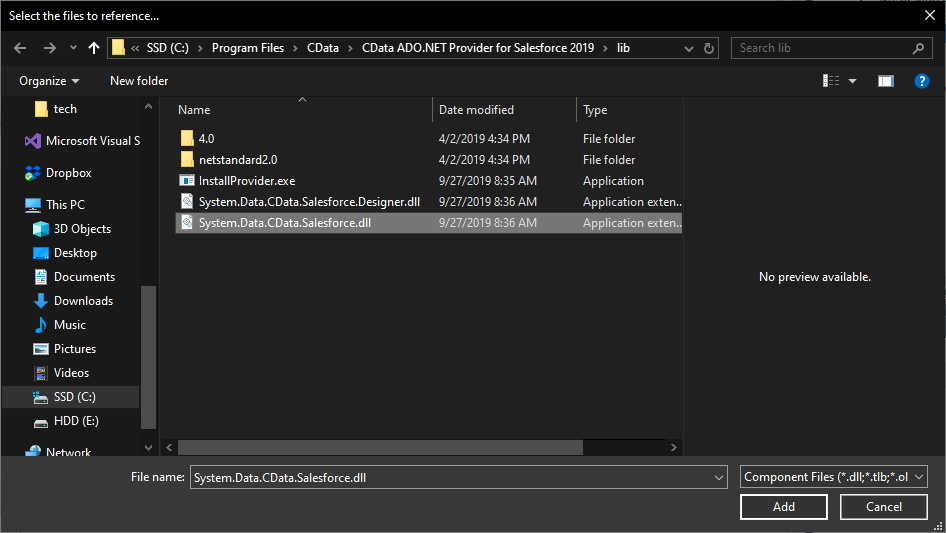
Next, add the Provider to the namespace, along with the standard Data library:
using System.Data.CData.EnterpriseDB; using System.Data;
Finally, add the code to connect to EnterpriseDB and query using the text from the TextBox to the Click event handler.
The following connection properties are required in order to connect to data.
- Server: The host name or IP of the server hosting the EnterpriseDB database.
- Port: The port of the server hosting the EnterpriseDB database.
You can also optionally set the following:
- Database: The default database to connect to when connecting to the EnterpriseDB Server. If this is not set, the user's default database will be used.
Connect Using Standard Authentication
To authenticate using standard authentication, set the following:
- User: The user which will be used to authenticate with the EnterpriseDB server.
- Password: The password which will be used to authenticate with the EnterpriseDB server.
Connect Using SSL Authentication
You can leverage SSL authentication to connect to EnterpriseDB data via a secure session. Configure the following connection properties to connect to data:
- SSLClientCert: Set this to the name of the certificate store for the client certificate. Used in the case of 2-way SSL, where truststore and keystore are kept on both the client and server machines.
- SSLClientCertPassword: If a client certificate store is password-protected, set this value to the store's password.
- SSLClientCertSubject: The subject of the TLS/SSL client certificate. Used to locate the certificate in the store.
- SSLClientCertType: The certificate type of the client store.
- SSLServerCert: The certificate to be accepted from the server.
private void Button_Click(object sender, RoutedEventArgs e)
{
//connecting to EnterpriseDB
string connString = "User=postgres;Password=admin;Database=postgres;Server=127.0.0.1;Port=5444";
using (var conn = new EnterpriseDBConnection(connString))
{
//using the query from the TextBox
var dataAdapter = new EnterpriseDBDataAdapter(textBox.Text, conn);
var table = new DataTable();
dataAdapter.Fill(table);
//passing the DataRowCollection to the DataContext
// for use in the XamDataGrid
this.DataContext = table.Rows;
}
}
Run the Application
With the app fully configured, we are ready to display EnterpriseDB data in our XamDataGrid. When you click "Execute," the app connects to EnterpriseDB and submits the SQL query through the CData ADO.NET Provider.
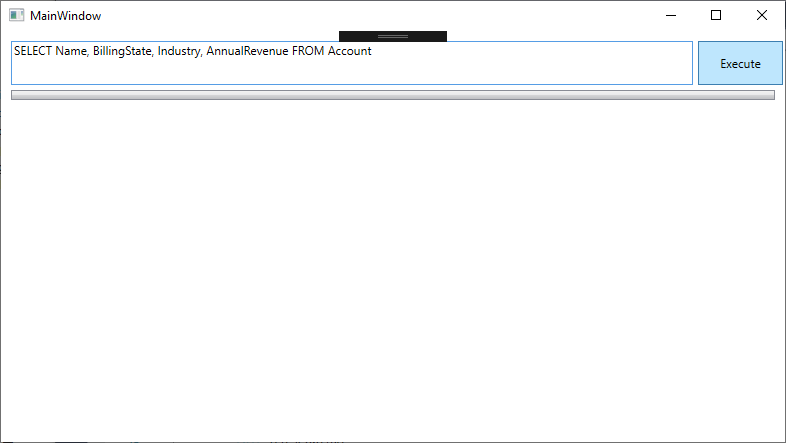
Live EnterpriseDB data is displayed in the grid.
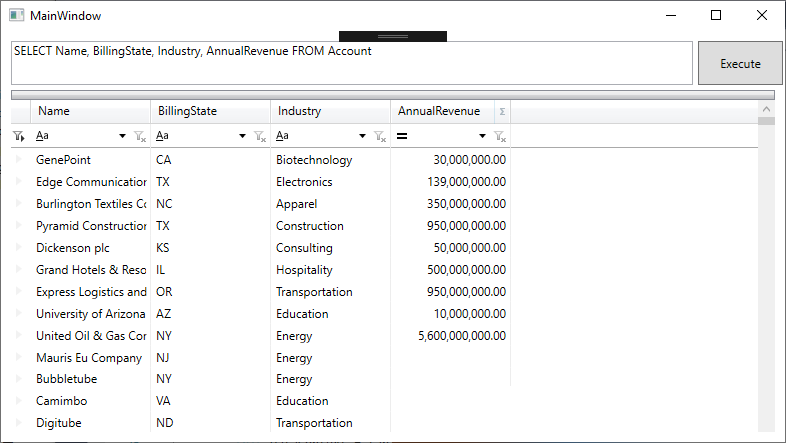
Group the data by dragging and dropping a column name into the header.
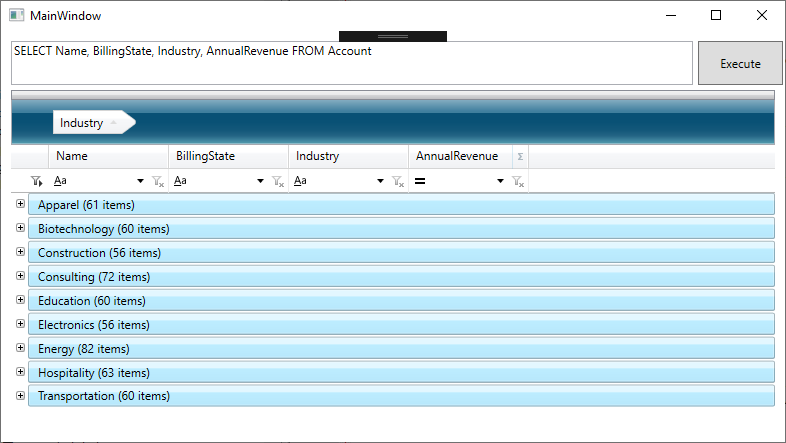
As you add groupings and filters, the underlying SQL query is submitted directly to EnterpriseDB, making it possible to drill down into live EnterpriseDB data to find only the specific information you need.
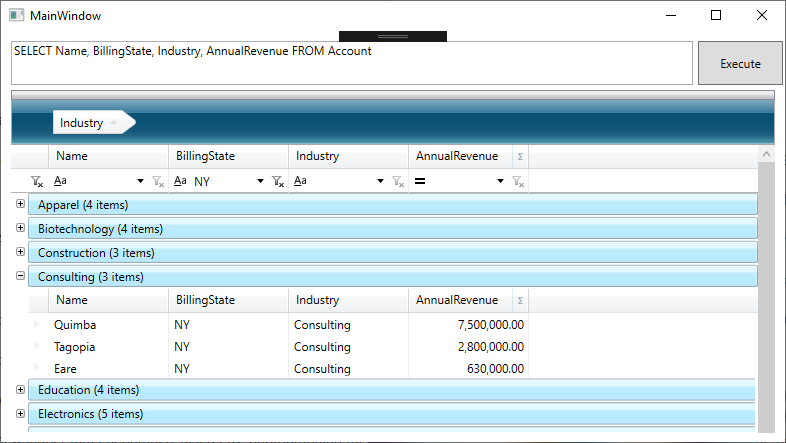
Free Trial & More Information
At this point, you have created a dynamic WPF App with access to live EnterpriseDB data. For more information, visit the CData ADO.NET Provider page. Download a free, 30-day trial and start working live EnterpriseDB data in apps built using the Infragistics UI controls today.






